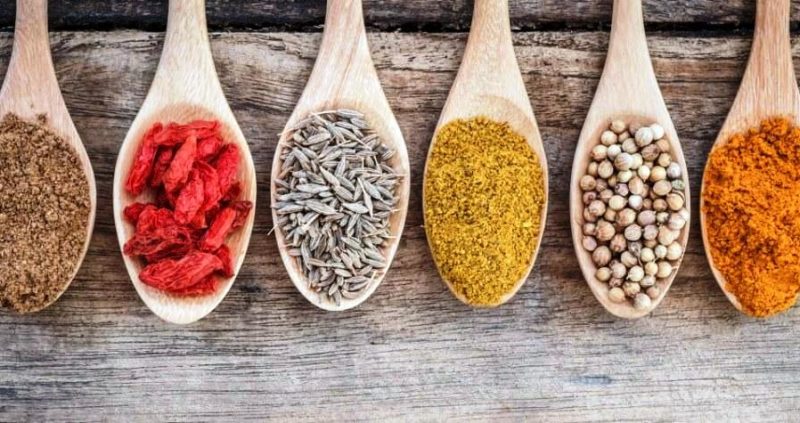A healthy diet is important for a healthy well being.In Ayurvedic terms, if you include all the six tastes in your meal, then only your diet is healthy and ideal.
Each taste has an effect on the mind and body. The physical and mental changes that you feel or go through are a result of the food you eat.
Moreover, the taste you consume also effects the doshas of the body.Thus, a diet encompassing all the six tastes is a must. To know more about it, scroll down.
Table of Contents
What Is Taste (or Rasa)?
Normally, we say the taste is the ability of our tongue to detect flavors of your foods. And we choose our foods as per our taste choices. Agree?
So, do you have any idea of how tastes influence your bodily functions?Yes, according to Ayurveda all the foods, beverages & medicinal herbs have some specific kind of tastes.
Each of the taste has some elemental properties that influence your health in many ways.
Ayurveda sees the tastes from a different dimension. It says tastes have a much more profound scientific significance than the way we usually think. Tastes have a direct connection with your bodily functions and constitution (Doshas).
Rasa is the special sense perceived through rasendriya or tongue (taste buds).
Rasa is the essence of your life and impacts of tastes have affects our overall health – starting from structure to emotional wellbeing, everything.
Moreover, tastes have tremendous therapeutic values. And when they are used in proper amounts, collectively they can heal any imbalances in your body and promotes good health.
Principles Of Taste In Ayurveda
In Ayurvedic terms, taste is called Rasa. Rasa is defined as the essence of life and affects your well being in every way from physical to mental.
It is the flavor of existence and the state of balance of mind, body, and soul.
The tastes play a major role in the health, physiology, and well being. The six tastes sweet, sour, pungent, salty, bitter, and astringent combine together to create the diversity of flavors in your life.
The same taste can be different for you depending on the level (grown or raised) of taste in your body.
The taste also varied on factors like where it was grown, how it was preserved, how it was stored, how it is cooked, and how fresh or old it is.
So, with taste, you can easily find out what you are consuming and what changes it will bring about in your body.
As per Ayurveda, you should relish the variety of flavors in your daily life. You should consume each and every flavor to let them positively affect your mind and body.
To enjoy the health benefits of taste you should make it a daily habit and must have a deeper understanding of each of them.
How Many Tastes Are There?
According to this, Ayurveda classified tastes are SIX types. They are — sweet, sour, salty, bitter, pungent, and astringent.
The six primary tastes are derived from five fundamental elements.
Each taste predominates two elements out of the five, and their combination is unique.
The Six basic Tastes and Their Elemental Composition:
- Earth and Water makes Sweet (Madhura)
- Earth and Fire makes Sour (Amla)
- Water and Fire makes Salty (Lavana)
- Fire and Air makes Pungent (Katu)
- Air and Space makes Bitter (Tikta)
- Air and Earth produces Astringent (Kashaya)
The Six Tastes and The Science Of Appropriate Diet
Food is all about eating sensibly. You have to remember that tastes are just elemental qualities, but the food is the fuel.
Imagine you have a car and want to refuel it. You go to the gas station…
…and choose the appropriate fuel for that machine—so you can achieve its optimal performance. Right?
But, what if you put kerosene in it?
Yes, it could actually drive. But you may not be able to accelerate to as you wish.
And down the road, it may lead to never-ending smoke and cough… Isn’t it?
Similarly, when it comes to food choices most of the people fall here. You are none other than those. You eat foods that are artificially cooked, seek for tastes that are inappropriate for your body constitution.
As a machine with a brain, your body also needs the right kind of fuel. Keeping that in mind, you have to understand what this machine actually needs and fill according to that.
Your Ayurvedic diets are dependent upon your Prakriti (constitution), vikriti (imbalances) and seasons. And to stay healthy, you need all the six tastes in your diet in specific amounts.
Ayurveda emphasizes this because those six basic tastes govern many functions in your body. They influence your mental and physical constitution mostly.
When your doshas are out of balance, those six basic tastes can help you repair that condition.
For example, If you have too little pitta dosha, then sweet foods will help you balance it. Similarly, taking sour foods may worsen the condition for you.
In fact, Tastes have the power to aggravate or pacify the doshas. This is why when an Ayurvedic doctor recommends you diets considering the tastes of the foods from all aspects.
The Six Tastes and Its Therapeutic Usage
In Ayurveda, to heal any ailments, you are most likely to get medicinal herbs as your treatment.
Also, Ayurvedic physicians always prescribe herbs to chew and taste. You will neither find any herbs that are compacted into capsules nor any herb that can be swallowed directly.
It is because each taste has its distinct medicinal value and it only works when the taste is perceived through the tongue.
And neither your gut nor the stomach has taste buds; so, swallowing capsules directly lessens the effects and benefits of tastes, because they are not perceived by the tongue.
By considering your body-mind type and any imbalances, an Ayurvedic doctor prescribes the required tastes. They have the power to repair the lacking dosha and bring back the vitality of your body.
It is one of the biggest reason why Ayurvedic medicines efficiently work—only when tasted. So, leet’s begin with each taste in detail:
1. Madhura (The Sweet Taste)
The sweet taste is familiar in all of your diets. It is pleasant, appealing to taste.
You get this taste in various sugar forms like glucose, sucrose, fructose, maltose, and lactose. You can find a tinge of this taste also in carbohydrates, fats, and proteins.
The properties of the sweet taste are given below:
- Primary Elements: Earth And Water
- Balancing Doshas: Vata and Pitta
- Aggravating Dosha: Kapha
- Virya (Temperature): Cooling
- Vipaka (post-digestive temperature): Sweet
- Qualities: Heavy, cold, oily, difficult to digest, grounding, building, nourishing, and soft
- Emotions associated: Love, sharing, joy, happiness, and compassion
- Location on the tongue: Front tip
- Direction of movement: Descending, stabilizing
- Additional properties: laxative, moistening, diuretic, antispasmodic, anti-inflammatory, and expectorant
Physical effects:
The Sweet taste gives you strength and longevity. If you are trying to gain weight, then the sweet taste can help you much.The sweet taste helps the mucous membranes in your body and the reproductive system.
When consumed in moderation, sweet taste is nutritious and promotes longevity. It enhances the growth of seven tissues of the body.
It strengthens your senses, improves the skin color, and beneficial for healthy skin, hair and voice.It relieves thirst, burning sensations and makes you feel full of energy.
Psychological effects:
Sweet tastes make you feel pleasant and satisfying. It nurtures the sattvic qualities — bliss, happiness, love, and compassion.Though it gives the feeling of love and sharing, when consumed in excess, develops greed and attachment.
Source of sweetness:
You will get the sweet taste in most of the sugary foods. It includes sugar, milk, wheat, rice, sugarcane juice, sweet fruits, butter, ghee, bread, pasta, honey, and dates to name a few.
Qualities:
The sweet taste has qualities like oily, cooling, and not easy to digest. It increases the vital essence of life.
Adverse effects:
Due to its qualities, the sweet taste is addictive.When used in excess, the sweet taste may create several disorders. Sweet foods aggravate Kapha Dosha. So, it may reduce appetite, increase mucus, heaviness, creates flatulence, colds, and coughs.
Overuse of the sweet taste may lead to toxins (ama), breathing problems, increased cholesterol, swollen lymph glands, tumors, diabetes, laziness and fibrocystic changes in the breast.
2. Amla (The Sour Taste)
The sour taste must be familiar to you. You particularly find it in acids like citrus acid, lactic acid, oxalic acid, and ascorbic acid.
You often Shrivel when you taste it. The taste immediately moistens your mouth and increases the flow of saliva in your mouth.
A small glimpse of the taste is given below:
- Balances: Vata dosha
- Aggravates: Pitta and Kapha dosha
- Primary element: Fire and earth
- Virya (temperature): Heating
- Vipaka ( post-digestive effect): Sour
- Qualities: Light, liquid, hot, and oily
- Associated with positive emotions: understanding, discrimination, appreciation, and comprehension
- Emotions when in excess: criticism, rejection, hate, agitation, selfish, hyperactive, and jealousy
- Location on the tongue: front edges along the curves
- The direction of movement: downward
- Additional actions: moistens, laxative, demulcent, and promotes heaviness
Physical effects:
The sour taste enhances the digestive power.It builds strength and helps in the stability of seven tissues in your body.When sour is used in moderation, it is delicious, refreshing and improves metabolism. Moreover, sour nourishes the heart and enlightens the mind.
Psychological Effects:
The sharp taste of sour makes your mind alert and boosts attention. In moderation, it brings appreciation but if overused, leads to hate and jealousy.
Source:
Citrus fruits oranges, lemon, green grapes, vinegar and fermented food, are the sources of Amla or sour taste.
Qualities: Sour has the gunas or qualities like hot, light, and oily.
Adverse effects:
When overused, sour taste creates excessive thirst, heartburn due to hyperacidity, ulcers and acid indigestion. It makes your teeth sensitive.
As sour has a fermenting quality, if consumed too much, it may become toxic to the blood and can create skin conditions like acne, boils, dermatitis, psoriasis.
Also, the hot quality of sour may create acidity by disturbing the natural pH level which may lead to burning sensation in chest, bladder, and urethra.
3. Lavana (The Salty Taste)
Salty taste is a standard flavor you find in your foods. It is used mostly in foods to make it more appetizing and delicious. Without this almost all the dishes are blunt.
The salty taste glimpse is given below:
- Balance: Vata
- Aggravate: Pitta and Kapha dosha
- Primary elements: Water and fire
- Virya (body temperature): Heating
- Vipaka (post-digestive effect): Sweet
- Quality: Heavy, oily and hot
- Associated with positive emotions: Courage, confidence, enthusiasm, and interest
- Excess emotions: Addiction, attachment, greed, irritability, and possessiveness
- Location on the tongue: rear edges of your tongue
- Direction of movement: downward
- Additional qualities: laxative, moistening, appetizer, and expectorant
Physical Effects:
Due to the water element, it has a laxative effect. And its fire element helps you sooth your colon by creating mucus.
If consumed properly, it stimulates saliva production, stabilizes the blood pressure by maintaining water electrolyte balances. It builds strength in muscles.
Apart from that, it enhances the flavor and color of foods, helps in digestion, food absorption, elimination of post-digestive wastes and lubricates tissues.
Psychological Effects:
Salty taste used as a taste enhancer of food. So, gives a pleasant effect, interest and it creates a kind of addiction.
Source:
Sea salt, table salt and rock salt, kelp are the sources of salty taste. Apart from these, salty nuts, salted chips & pickles also give the salty taste.
Qualities:
Salt is hot, heavy, and oily by its nature.
Adverse Effects:
When overused the salty taste makes the blood thick and viscous. Skin wrinkling and baldness may also occur. Apart from that, it can trigger bleeding disorders, hyperacidity.
4. Katu (The Pungent Taste)
Pungent is the hottest taste among all six. It is one the dry heat taste and you can find it in spicy food especially the herbs and spices.
It is formed due to volatile oils, resins, and mustard glycosides. After eating this, the tissues and nerve ending of the mouth get a heated sensation.
The properties of the taste at a glance:
- Balance: Kapha
- Aggravate: Pitta and Vata
- Primary elements: Air and fire
- Virya (temperature): heating
- Vipaka (post-digestive effect): Pungent
- Qualities: hot, dry, light, sharp, and aromatic
- Associated emotions: enthusiasm, curiosity, clarity, vigor, vitality, and concentration
- Excess Emotions: Irritability, anger, rage, competitiveness, and envy
- Location on tongue: Central region of the tongue
- Direction of movement: Upward and lightening
- Additional qualities: Deworming, antiparasitic, antispasmodic, vasodilator, and blood- thinning effect
Physical effects:
When used in moderation, the Pungent taste stimulates the digestive fires, improves digestion. It cleans mouth and clears the sinuses.
The pungent taste helps in clotting, blood circulation, and elimination of waste products. It kills germs and parasites, relieves muscle pain. It causes tears in eyes if consumed in large amounts.
Psychological effects:
Due to its sharp taste, it creates a penetrating impact on the mind. It lets your mind bright, alert and brings clarity in perception.
Source:
You will find pungent taste in hot peppers (Chili, cayenne pepper, habanero pepper and black pepper). Apart from this, spice ingredients like onions, ginger, garlic, radishes, mustard are also pungent in taste.
Qualities: Pungent is hot, drying, and light in nature.
Adverse effects:
Pungent food causes irritation and inflammation in the colon when consumed too much. It destroys virility causing sexual debility in both sexes. It can kill sperm and ova.
By irritating the digestive system, it causes diarrhea, nausea, heartburn, stomach ulcers, insomnia.Due to the heating effect, you may feel choking, fainting, and fatigue with feelings of heat and thirst.
It can develop dizziness, tremors, insomnia, or pain in the leg muscles. Peptic ulcers, asthma, colitis, and skin conditions may result from excessive use.
5. Tikta (The bitter taste)
The bitter taste is not so appealing and brings out the flavor of other tastes. You must be familiar with it but people usually avoid it. You shouldn’t avoid this taste as it has therapeutic benefits.
The properties of bitter taste are as follows:
- Balances: Pitta and Kapha
- Aggravates: Vata
- Primary elements: Air and ether
- Virya (temperature): Cooling
- Vipaka (post-digestive effect): pungent
- Qualities: Cold, light, and dry
- Associated with positive emotions: mental clarity, self-awareness, and the healthy detachment from worldly luxuries
- Excess emotions: Rejection, boredom, isolation, and loneliness
- Location of the tongue: Middle edge on the left and right sides
- The direction of movement: downward
- Additional qualities: stimulates the nervous systems, anti-inflammatory, antibacterial, anti-viral, promotes the healthy flow of bile, and inhibits lust
Physical effects:
It is an active antibiotic, antiparasitic, antiseptic and an excellent detoxifying agent. It soothes the burning sensations. It nourishes the skin, muscles and reduces skin diseases like itching.When used in small amounts, it helps in relieving the intestinal gas and promotes digestion. It also helps in reducing body weight and fat.
Psychological effects:
Due to its unpleasant taste, it may cause bitterness and creates negativity. Too little bitter can lead to loss of motivation.Also, bitter taste helps your stay away from objects of desire. It promotes spiritual growth.
Source:
Sources of this taste are bitter gourd and bitter melon, Aloe Vera, rhubarb. Herbs like neem (Azadirachta Indica), fenugreek, sandalwood turmeric root, dandelion root are examples of the bitter taste.
Qualities: The bitter taste shows these qualities— cool, light, and dry.
Adverse Effects:
When bitter taste is consumed too much, it leads to loss of strength and energy. This taste shows the spermicidal results.Moreover, excess use of bitter taste may decrease the plasma, blood, and muscles. Sometimes it may create dizziness and unconsciousness.
6. Astringent (The Kasaya Taste)
Astringent taste is due to the predominance of Air and Ether elements. It is the least common of all the six tastes, and when consumed, it creates a chalky feeling inside the mouth.
The properties of the taste at a glance are given below:
- Balance: Pitta and Kapha
- Aggravates: Vata
- Virya (temperature): Cooling
- Vipaka (post-digestive effect): Pungent
- Qualities: Dry, cold, and heavy
- Associated with positive emotion: grounded, stable, and collected
- Excess emotion: Fear, anxiety, depression, harshness, nervousness, and rigidity
- location on the tongue: central region at the back of the tongue
- Direction of movement: draws inward
- Additional qualities: Reduces sweating, cool excess heat, anti-inflammatory, hemostatic, and astringent
Physical effects:
Astringent has a drying nature, and it helps in binding stools. It promotes healing ulcers and stops bleeding by its clotting nature. It has anti-inflammatory qualities that are helpful for your body.
It has a drying effect; it draws the water out of the body cells/tissues.
Psychological effects:
Astringent can weaken the spiritual growth. When in excess, it dries up the inspiration, and when too little it makes you sentimental and overemotional.
Source:
Astringent is present in the foods that make dryness in your mouth when consumed. It includes, unripe banana, chickpeas, alum, and okra are high-grade sources of astringent taste.
Green bananas, chickpeas, green beans, lentil, black tea, okra, alfalfa sprouts, pomegranates, beans. Arjuna.
Qualities: It is cooling, drying, stable and heavy.
Adverse Effects:
Overuse of astringent causes dryness of mouth, difficulty in speaking, constipation, and distension of abdomen. Prolonged consumption may cause a loss in sperm count and can result in reduced sex-drive.
If consumed too much, Over time it leads to abnormal weight loss, heart spasms and stagnation of blood circulation.
Apart from that, it can cause neuromuscular disorders like convulsions, stroke paralysis, Bell’s palsy etc.
Final Talk
The six tastes are a blessing given to us by the mother nature. You should consume all the taste as all of them are necessary. A balanced diet includes an appropriate quantity of all the six tastes.
Although, the amount that you should take depends upon individuals Prakriti. You should know your Prakriti and then maintain the state of balance by eating them as per your body constitution.






